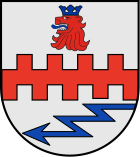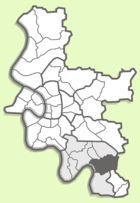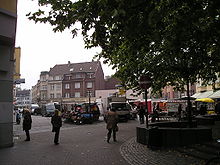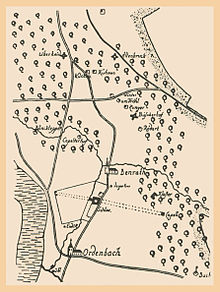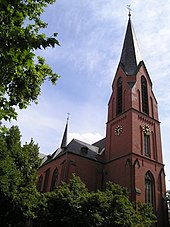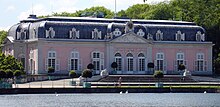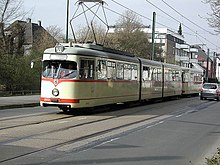Benrath
|
Benrath district of the state capital Düsseldorf |
|||
|---|---|---|---|
|
|
|||
| Basic data | |||
| Geographic location : | 51 ° 10 ′ N , 6 ° 52 ′ E | ||
| Height: | 38 m above sea level | ||
| Surface: | 6.02 km² | ||
| Residents: | 16,751 (December 31, 2018) | ||
| Population density : | 2,783 inhabitants per km² | ||
| Incorporation : | August 1, 1929 | ||
| District: | District 9 | ||
| District number: | 095 | ||
| Transport links | |||
| Autobahn : |
|
||
| Bundesstrasse : |
|
||
| DB regional traffic : | RE 1 RE 5 | ||
| S-Bahn : | S 6 P 68 | ||
| Light rail : | U 71 U 74 U 83 | ||
| Bus route: | 730 778 779 784 788 789 M 1 | ||
| Night traffic: | NE 7 815 817 | ||
Benrath is one of the southern districts of Düsseldorf and lies on the Rhine and the Itter (stream from the Bergisches Land; rises near Gräfrath ). Benrath belongs to the district 9 of the city of Düsseldorf and extends over an area of 6.02 km² with 16,735 inhabitants. This corresponds to a population density of 2,780 inhabitants / km².
history
Development up to around 1800
Originally the area around today's Benrath was called "Rode" ("clearing" or "cleared area"), also called "Roide" (with Dehnungs-i). The name Benrath is derived from Benrode . In a document from 1210, a Gerlacus de Rode is given as one of the witnesses. In 1222 the name Benrode was first used in a Cologne document. An "Everhardus de Benrode" is also listed as a witness. This is also mentioned in other documents from 1224, 1227 and 1241. In documents from the end of the 14th century, the name “de Royde” or “von Royde” is used more often instead of “Benrode”.
In addition to the noblemen de Benrode, there was at least one other noble family in the area of Benrath in the 13th century who owned "feudal" property. In a document from 1299 five lay judges from Neuss confirm that two sons of the knight Tilmann Kase have inherited their inherited allodial property Kappel in "Rayde" of the abbess and the convent of St. Klara in Neuss. The estate comprised buildings, barns, 3 acres of farmland (180 acres), 5 acres of meadows and 3 acres of forest. A tithe had to be paid to the main Mickel farm for only 12 acres of arable land .
The temporary residence of the Counts of Berg in the area of the former castle of Lords "de Benrode" in Benrath has been documented since 1330 . The property must have already been taken over by the Counts of Berg at this point, as the right of ownership to Benrath Castle is also mentioned. The Lords of Benrode settled again on the left bank of the Rhine and then called themselves "van Scheven" according to the document of March 24, 1410. In another document of April 4, 1414, the brothers Godart and Johan "van Benroide gnant van Scheven" are listed.
In 1405, the castle courtyard, which emerged from the castle of Mr. de Benrode, the widow of Duke Wilhelm II , Anna von Baiern, was transferred as a widow's seat. This castle courtyard was a little further to the east than today's castle courtyard, which is located in the area of the orangery. This, however, is the remaining part of a new moated castle built between 1651 and 1674. This, in turn, was largely demolished for today's hunting lodge , which was built in the second half of the 18th century. The old courtyard, which can be traced back to the original first castle of the gentlemen de Benrode, was demolished in 1778 and the present courtyard was then rebuilt.
At the beginning of the 14th century, the entire corridor area of today's Düsseldorf city district 9 was sparsely populated. In the immediate vicinity of Benrath there were various knight seats , such as Elbroich , Eller , Garath , Horst , Mickeln and Overheid as well as several larger farms . These courtyards were probably originally partly manors or noble estates. Below are some important farms with the year for the first available documents: the Buscher Hof (1617), the Buchholzer Hof (1438), the Fronhof (904), the Hellerhof (1447), the Kappeler Hof (1299), the Niederheider Hof (15th century), the Növener Hof (1392), and the parish or Wiedenhof (1610). Only the Niederheider Hof, today part of Holthausen, and the Fronhof, today part of Himmelgeist , are still there. Only street names are reminiscent of the other courtyards. The Fronhof is of particular interest because it is the oldest settlement in the south of Düsseldorf that can be documented in writing. It emerged from a royal estate of the Carolingians . In a document dated August 2 904, the court of was Ludwig IV, the child the pen in Kaiserswerth for permanent stipend left (living).
The village of Benrath slowly emerged parallel to the development of the Benrod Castle, its conversion into a moated castle (1484), the subsequent construction of a moated castle (completed in 1674) and the later hunting lodge (construction began in 1756). While the church in Benrath can be documented in writing as early as 1299, Duke Wilhelm I did not mention both the castle and a village of Benrath in a document from 1405 .
The settlement area of Benrath was subordinate to other then more important communities in the vicinity until about the end of the 18th century. In a document from 1555 the affiliation for the judicial area Amt Monheim is stated as follows for 1363 : The Unteramt Monheim was responsible for: Bilk, Hamm and Himmelgeist. Benrath and Itter belonged to Himmelgeist. Urdenbach , on the other hand, is given at the Monheim District Office. In documents from 1507 and 1523 in the 16th century, Benrath is assigned to the court area up the Vrdenbach or also at the Vyrdenbach . At the beginning of the 18th century, Benrath again belonged to the Monheim sub-office , while Urdenbach remained unchanged under the upper office.
Simple plans drawn around 1715 and around 1850 still show a few buildings in the area of today's Börchemstrasse and Hauptstrasse. In the plan from 1715, however, a parish church of St. Cäcilia is already entered. Older documents are also available from the parish of Benrath. The oldest is from 1299. In this a church of St. Cäcilia in Benrath is already mentioned. In the purchase contract of the Kappeler Hof by the Klarissenstift in Neuss it was stated that the court was obliged to provide the "parish in Royde" with wax for the lighting. In another document, dated October 28, 1609, a deputy curate of the church at Benrath, Conradus vam Dham de Wanckum , was awarded a severance payment.
A stronger appreciation of the community of Benrath compared to the neighboring towns began at the end of the 18th century with the construction of today's hunting lodge and with the changes during the Napoleonic era. On March 15, 1806, the Duchy of Berg was given to Napoleon's brother-in-law, Joachim Murat . He chose Benrath Palace as his residence. With a decree of October 13, 1807, the Monheim office was replaced by the canton of Richrath . In 1808 four municipalities belonged to this . One of the four was Benrath with the villages: Garath, Himmelgeist, Holthausen, Itter, Urdenbach and Wersten.
After the end of the French period in 1813, the Berg Generalgouvernement belonged to Prussia from November 1813 to April 1815, initially provisionally and then finally, in accordance with the resolutions of the Congress of Vienna . On April 15, 1814, a (Ge) Samtgemeinde Benrath was formed according to a decree. The communities Eller and Hilden were included in this community in addition to the localities from 1808. Groß-Benrath, apart from Eller and Hilden, corresponded to the area that was valid for Düsseldorf until Wersten left in 1908.
Gross-Benrath
Since the formation of the Canton Rich Rath by the French Benrath was one of the four municipalities main parish become in today south of Düsseldorf. This did not change when the Rhineland officially belonged to Prussia after 1813 and from 1815. These took over the French administrative structure without major changes. The following independent rural communities belonged to the mayor's office of Benrath: Garath, Hilden-Eller, Himmelgeist-Wersten, Itter-Holthausen and Urdenbach.
Already in 1808 under the French as mayor (French: Maire ) was used Peter Urkhaus, the tenant of the courtyard, this office held until 1814. He was succeeded by Nicolas Pigage, in the French period already the first Assistant Secretary of the Mairie Benrath been was. Apart from Benrath, Nicolas von Pigage was also mayor of the rural community Hilden-Eller, which belonged to the entire community. Hermann Leven followed as mayor in Benrath from 1819 to 1822 and Franz Albert Schieß from 1822 to 1842.
In 1842 the communities Eller and Hilden left the community as a whole. On July 23, 1845, the Rhenish Rural Community Code came into force, which did not bring any changes for the Mayor of Benrath with regard to the associated communities. The other mayors from 1843 were: until 1864 Peter Urban Leven, 1865–1893 Hermann Josten and 1894–1906 Michael Steinhauer.
From the first major area revision for Düsseldorf in 1908/1909, in which various rural communities were incorporated into Düsseldorf, Benrath emerged even stronger. The number of residents in the area of the mayor's office Benrath with Garath and Himmelgeist-Wersten was 23,634 in 1908, of which 10,258 were in the area of Benrath.
However, the municipality of Wersten separated on April 1, 1908 from the association with Benrath and Himmelgeist followed in 1909, since the incorporation contract with Düsseldorf was signed on February 5. The previously independent rural communities in the rural mayor's office of Benrath were merged into the rural community of Benrath in a decree issued by Emperor Wilhelm II on April 21, 1908. Only Garath was not affected by the merger. The mayor's office of Benrath now consisted of the two independent communities of Benrath and Garath. Gross-Benrath , as the residents called them, had been formed. At the same time, the municipality boundaries in the northeast were changed for Benrath. Wersten ceded the rest of the Hallbusch area to Holthausen and Eller ceded the Steele area from Altenbrückstrasse to Hassels. These two parts of the community belonged to Groß-Benrath. The large community came into being during the tenure of Benrath mayor Julius Melies (1906–1926). This was followed in 1926–1929 as the last Erich Custodis.
Due to the successful development of Groß-Benrath from the middle of the 19th century with high tax revenue for the community, there were considerations from the turn of the century to obtain city rights. Therefore, among other things, the construction of a representative town hall was planned. Until 1890, a building in the Hildener Strasse / Paulistraße area was used as the town hall and a building on Urdenbacher Allee / Hildener Straße until 1908. With the construction of the new town hall in 1906 on Benrodestrasse, the desire for city rights was reinforced.
At the same time, some communities endeavored to leave the Groß-Benrath network. After the departure of the municipality of Wersten in 1908, Himmelgeist followed on February 8, 1909. Groß-Benrath now consisted of the following three rural communities: Benrath, Itter-Holthausen and Urdenbach. In detail, these were the following additional parts of the community that belonged to Benrath: Hassels , Holthausen , Itter , Niederheid, Oberheid, Paulsmühle , Reisholz , Rittersberg and Urdenbach . As already mentioned, the municipality of Garath with Hellerhof was an independent municipality within the mayor's office of Benrath until 1929 and thus had a special status. This also concerned the sending of members to the mayors' meeting. The former manor in Garath, Rittmeister a. D. Alhard von Burgsdorff was and remained a member of parliament without an election. In addition, there was an elected member for Garath.
At the beginning of the 1920s, the plan for the construction of a large industrial port in the area of the Old Rhine in Urdenbach was drawn up. Part of this plan was the incorporation of Groß-Benrath and the communities of Monheim and Baumberg into Düsseldorf. The plan was not carried out and the incorporation of Benrath took place a few years later.
In 1929, Groß-Benrath was incorporated into Düsseldorf as part of the reorganization of the administrative districts of Düsseldorf , Münster and Arnsberg, despite fierce resistance from the Benrathers. As a concession, the Benrath citizens were granted a separate administrative advisory board and their own administrative office by the city of Düsseldorf according to an order of October 8, 1929. The special rights obtained in this way, some of which still apply today, are, for example, a separate district representation , a separate Federal Employment Agency and a separate registry office .
Industry development
With the opening of the Düsseldorf-Deutz railway line on December 15, 1845 and the Benrath train station, the transformation of the village structure into an industrial location began. While there was only the Bünger barrel factory in the municipality in 1823, this has now changed. By 1890, 17 companies, in 1908 47 companies with 6,438 employees and in 1928 before the incorporation, 52 companies with 12,133 employees had settled in Groß-Benrath.
With advancing industrialization as a result of extensive traffic engineering (railroad, electrified local transport networks), settlements at the end of the 19th century mainly in the districts of Holthausen, Reisholz and Paulsmühle (the part of Benrath southeast of the Cologne-Düsseldorf railway embankment, at that time a section of the " Cöln-Mindener " until 1879 private Eisenbahn-Gesellschaft ") industrial companies, some of which soon achieved international recognition:
- the tubular rolling mill "Balcke & Co." (founded in 1874 by Balcke and HA Flender), which merged in 1899 to "Balcke, Tellering & Co."
- the bridge and steel construction company "Hermann August Flender" (1901; main plant sold to "Hein, Lehmann & Co. AG" in Oberbilk in 1931, the site taken over by "Capito & Klein"); this company built z. B. Hamburg's Elbe bridges and the steel structure for the domed roof of the Düsseldorf Tonhalle when it was still a planetarium .
- sheet metal production "Capito & Klein" on Telleringstrasse (founded in 1876; became a Krupp company in 1938 ; sheet metal production on Telleringstrasse (rolling mill I) ceased in 1976); Krupp-Walzwerk II opened in 1955 on Hildener Strasse (Krupp-Stahl- Nirosta production). In 2012 the rolling mill became the Outopumku-Nirosta rolling mill through sale . On September 23, 2016, the rolling mill in Benrath ended and machines and systems were relocated to the parallel mill in Krefeld.
- the “Benrather Maschinenfabrik” (1896) with its world-leading crane production, especially electric harbor overhead and slewing cranes with AEG electric motors. The merger with two foreign companies (1910) resulted in "Deutsche Maschinenfabrik AG" ( DEMAG ), which merged with Thyssen & Co. in 1926. In their successor, " Gottwald Port Technology " now produces at the same location as one of the world's leading companies for mobile harbor cranes, the large parts of which are exported all over the world via the Reisholz harbor. Gottwald has been producing in cooperation with "DEMAG Cranes & Components GmbH", Wetter a. d. Ruhr, under the newly founded Düsseldorf-Benrather Holding " DEMAG Cranes AG ", whereby the old founding name DEMAG in Benrath no longer only exists as a street name.
- the "DEMAG Baggerfabrik GmbH" (built 1937-1939 next to the above-mentioned DEMAG site), 1968 as "DEMAG Bagger und Kran GMBH", 1979 as "Mannesmann DEMAG Baumaschinen", 1996 as "DEMAG Komatsu ", which continued until recently came up with world novelties (including the largest telescopic crane, crawler crane, hydraulic excavator). The name DEMAG - like the name Mannesmann before - has expired with the complete takeover by Benrather "Komatsu Mining Germany" (1999) in this division.
- The Henkel company, founded in Aachen in 1876 , moved to Düsseldorf in 1878 and began producing detergents in Holthausen in 1900 . With the development of the first heavy-duty detergent Persil in 1907 and the start of the production of adhesives in 1922, the foundation stone was laid for today's globally active group.
This brought, as well as the emergence of the Reisholz industrial terrain , a significant immigration of population for Benrath. By creating a fortified market square near the parish church, a coherent town center with a main shopping street was created (the original Dorfstraße, renamed Mittelstraße in 1908 and renamed Hauptstraße since it was incorporated into Düsseldorf in 1929; now a pedestrian zone).
Workers 'settlements were also built (especially on the Paulsmühle), but also entrepreneurial villas (in the area west of the castle towards the Rhine) as well as civil servants' and employee apartments (in the center, around the market square).
The largely preserved Art Nouveau buildings around the old town hall in Benrodestrasse and Sophienstrasse with many listed buildings are particularly worth seeing.
With the restructuring of manufacturing technology through electronics, the specialization and concentration of production in as few locations as possible, however, there was a loss of jobs in all areas of industry from the end of the 20th century. In the former municipality of Groß-Benrath, this also leads to job cuts, the relocation of production to other locations and the resulting closure of companies.
coat of arms
The Benrath coat of arms, which is currently still in use, was created by Adolf Matthias Hildebrandt and accepted by the mayors' meeting on February 11, 1910. Blazon (description): In the silver (white) shield divided by a red pinnacle bar above a blue crowned and tongued red lion head; below a lying right-hand blue, four-fold jagged lightning bolt.
Meaning: The lion's head and the alternating battlement are derived from the coat of arms of the counts and dukes of the Duchy of Berg , who ruled the area for several centuries. The lightning symbolizes the Reisholz power station built in 1906 , which used to belong to the large community of Benrath; at times the largest hard coal power plant in the world.
Benrather line - language border
In the linguistic sciences, the term Benrath line has become a term for the isogloss make - maken . Along this line running eastwards towards Berlin , the dialect continuum of the continental West Germanic languages is divided into the Lower Franconian , Low German and High German languages .
Church and religion
The history of church life in Benrath probably goes back to the year 1005, when the first stone church was built on the site of today's Catholic parish church St. Cäcilia . However, this date is controversial and goes back to a find by the pastor Ferdinand Heubes in the 19th century. He had found the old stone, probably from the apse of the first building, when the Romanesque church was demolished in 1822 and interpreted its inscription accordingly. He owed no proof of its correctness.
The oldest document with a reference to a church in Royde is from the end of the 13th century. A pastor named Everard from Rayde is also documented in 1368. If the first church in Benrath was not built until later than the beginning of the 11th century, it was a small Romanesque church with a tower that lasted into the year 1929 stood before that of today's church. The Romanesque nave was replaced by a new classical building in 1822 . This building was built at the instigation of Pastor Heubes (Pastor in Benrath from 1804 to 1863).
After advancing industrialization and the increase in population also made this church too small, it was decided at the beginning of the 20th century to completely rebuild it and from 1901 to 1903 the current neo-Gothic church was built. On September 11, 1902, the first service was held in the not yet completed new church. This was followed by the demolition of the old church nave from 1822 on September 15, 1902. Even then, the value of the Romanesque tower was recognized and it was left standing. This resulted in the double towers already described, which for many years should become one of the landmarks of Benrath. In 1929, immediately after the involuntary incorporation to Düsseldorf, she fell victim to the increasing traffic.
In the period after the Reformation , on the instructions of Duke Wolfgang Wilhelm, the Reformed faith was preached in it for seven years (1609–1616). After his return to Catholicism , the Duke arranged for the church to be returned to the Catholic community in 1616. The Reformed then withdrew to the neighboring fishing and rafting village of Urdenbach under their pastor Thomas Kohlhagen . There the development of their community was favored by the influx of religious refugees from the Netherlands , which at the time was still under Spanish rule . The baroque sermon church built in Urdenbach has been preserved to this day and also served the Benrath Protestants until the Church of Thanksgiving was built on Weststrasse (1915). The strong growth of the Protestant parish led 1962–1964 to the building of the Adoration Church in Hassels.
The Catholic community belongs to the Archdiocese of Cologne , the Protestant community to the Evangelical Church in the Rhineland .
Until 1938 there was also a small Jewish community in Benrath , their synagogue was in a back yard on Friedhofstrasse.
Place of pilgrimage
In today's Catholic parish church of St. Cäcilia, the so-called "miraculous image of the Black Mother of God of Benrath" is kept, which was created by Count Palatine Philipp Wilhelm (1615–1690) and his second wife Elisabeth Amalie Magdalene (1635–1709) as a copy of the statue of Mary from Einsiedeln came to Benrath in Switzerland. The princely couple was very close to the Catholic faith and especially to the piety of Mary. According to legend, they heard the people of Benrath tell of an apparition of Mary and an inexplicable song in the forest (on today's “Black Path” between Hildener Straße and Urdenbach). Both convinced themselves of the correctness of this report and had a chapel built for the statue of the Virgin on the site of the apparition in 1677. The chapel, consecrated by the Cologne bishop Paul von Aussem , immediately experienced such a great rush of pilgrims that the vicar Kapuziner from the Noven monastery (Einsiedel house on Hildener Strasse, demolished in 1934) was put to the side. For more than 200 years on the feast of the Visitation of the Virgin Mary on July 2nd, a procession from St. Lambertus in Düsseldorf to the “Black Mother of God” in Benrath. During the French period (from 1806) the so-called “black chapel”, known by the Benrathers, was misused as a soldiers' bar in the course of general secularization and was finally torn down. The foundation stone of the old chapel, found again in 1959 on the Schwarzen Weg, can be viewed in the Marienkapelle of the parish church of St. Cäcilia. The miraculous image could have been saved; it was buried in time by the priests. Pastor Heubes then had it installed in the parish church in 1806. Even today, on every second Sunday in October, the Benraths carry the miraculous image from the parish church to the palace terrace on the park side and then on - in a festive light procession - around the mirror pond in the palace park .
Attractions
Northwest of the main street in Benrath is the hunting and summer residence of the former Elector Palatine Karl Theodor in rococo style (1756-1770), later Prussian Royal Castle, the Benrather castle with its extensive park system. This extends to the banks of the Rhine. Several museums are housed in the outbuildings of the castle. The castle is basically the somewhat smaller version of the Schwetzingen castle and was the summer residence of the elector.

Also worth seeing are the town hall of the formerly independent community of Benrath (1906, in the so-called Weser Renaissance style, built by Walter Furthmann ), the Protestant Church of Thanks (1914–1915, neo-baroque , built by Friedrich Pützer and Lyonel Wehner ) and the Catholic St. -Cäcilia-Kirche (1901–1903, neo-Gothic , built by Wilhelm Sültenfuß ). The St. Cäcilia Church is the third sacred building at this point. It is the successor to a classicist church, which in turn was the successor to a Romanesque church. The place where the Romanesque church tower stood until 1929 is marked in the pavement of the main street in front of the St. Cäcilia Church.
Furthermore, the old post office “Haus Spilles” (built around 1800, today a youth culture center) and numerous Wilhelminian-style buildings in the area of Benrather Schlossallee, Sophienstrasse, Benrodestrasse, Meliesallee and Görresstrasse are remarkable.
Public facilities
The Benrath Hospital, which opened in Benrath on Hospitalstrasse in 1892, was relocated to a new building on Urdenbacher Allee in 1961 and expanded in 1999 and 2004. Other facilities are the Benrath senior citizen center on Kolhagenstrasse and the Benrath public and outdoor swimming pool on Regerstrasse.
Regular events
July
- The Benrath Schützenfest takes place on four days on the first Sunday in July.
August
- On the first weekend in August, the Benrath Beer Exchange takes place on three days.
- The Düsseldorf Mopped-Schützen-Treffen takes place on a Saturday in August, a benefit event for the benefit of the Regenbogenland children's hospice.
- Castle park concerts, organized by the home community Groß-Benrath eV
September
- On the second weekend in September the traditional Prummekirmes takes place in the Benrath pedestrian zone.
October
- On the second Sunday in October there is a light procession through the palace gardens around the mirror pond with the miraculous image of the "Black Mother of God of Benrath".
November and December
- Advent market and Christmas market
schools
- Annette-von-Droste-Hülshoff-Gymnasium
- Schloss-Gymnasium Benrath
- Realschule Benrath
- Community secondary school Benrath
- Confessional primary schools: Catholic St. Cäcilia School and Catholic primary school Einsiedelstraße
- Community elementary school Schloss Benrath
sports clubs
- TSG Benrath 1881 eV
- Rowing Society Benrath 1908 eV
- Sportgemeinschaft Benrath-Hassels 1910/12 eV
- Tennis club Benrath 1912 eV
- VfL Benrath 06 eV
- Rifle Brotherhood St. Cäcilia Benrath eV from 1553
- DEC Devils eV - women's ice hockey in Düsseldorf
- TTC Benrath 1983 eV - Benrath table tennis club
Sports facilities
- Sparkasse ice rink , foundation of Stadtsparkasse Düsseldorf, Paulsmühlenstrasse 6
- Karl-Hohmann-Stadion, Karl-Hohmann-Strasse 70
Personalities
- Marie Sophie von Pfalz-Neuburg (1666–1699), Queen of Portugal
- Maria Anna von Pfalz-Neuburg (1667–1740), Queen of Spain, Naples, Sicily and Sardinia, Duchess of Milan
- Hans von Monbart (1838–1898), Lieutenant General
- Ferdinand Freiherr von Wolff-Metternich (1855–1919), member of the Reichstag
- Wilhelm von Hohenzollern (1864–1927), head of the House of Hohenzollern-Sigmaringen (1905–1927)
- Hugo Leven (1874–1956), sculptor
- Werner Freiherr von Fritsch (1880–1939), Colonel General
- Harry Piel (1892–1963), director and actor
- Karl Hohmann (1908–1974), German national soccer player
- Heinrich Havermann (1909–1971), university professor
- Pieter van de Cuylen (1909–1990), painter
- Adalbert Klein (1913–1994), art historian, from 1953 to 1978 director of the Hetjens Museum
- Paul Mebus (1920–1993), football player
- Wolfgang Obladen (1924–2000), Lord Mayor of Leverkusen
- Irene Markowitz (1925–2010), art historian, curator of Benrath Palace
Hiking trails
The following marked hiking trails of the Sauerland Mountain Association (SGV.) Begin or end in Benrath :
- The Schlösserweg, signpost X19 : Benrath, train station - Dillenburg in Hessen
- The Düsseldorfer Weg, signpost D : Benrath, Schöne Aussicht– Kaiserswerth
traffic
Benrath owns a regional train station on the Cologne – Duisburg line of the historic Cologne-Minden Railway Company . The station is an early modern brick building from the 1930s and the second station at this point. Regional express and S-Bahn trains on lines RE 1, RE 5, S 6 and S 68 of Deutsche Bahn operate there.
Two rail lines of the Rhine course , the lines U71 and U83 as well as a morning ride the U74 connect Benrath Düsseldorf city center. There are also bus routes 730 Urdenbach– Lohausen , 778/779 Garath circuit, 784 Urdenbach - Hilden - Wuppertal / Vohwinkel , 788 Benrath Ost– Monheim am Rhein ( Heerweg bus ) and 789 Holthausen – Monheim am Rhein ( Heerweg bus ) in the Benrath area.
Until 1962 a mostly single-track meter-gauge tram ran from Benrath (beginning in Paulistraße) via Hilden to Solingen-Ohligs or to Haan and Wuppertal-Vohwinkel . This narrow-gauge railway originally went beyond Benrath to Düsseldorf, Oberbilker Markt, and formed the so-called "Benrath network", which was bought by the city of Düsseldorf in 1910, before Benrath was incorporated. In the Bergisches Straßenbahnmuseum in Wuppertal-Kohlfurth, railcar No. 107 of this narrow-gauge line has been preserved in running order.
There is a junction “Düsseldorf-Benrath” on the A 59 motorway .
The passenger ships that used to run in spring and summer on the Rhine from Benrath to Zons no longer operate for economic reasons. The year-round car and passenger ferry from Urdenbach on the eastern bank of the Rhine to Feste Zons on the western bank of the Rhine provides a fast connection to the western bank of the Rhine.
The cultural committee of the state capital Düsseldorf commissioned the city archive and the memorial and memorial site in March 2018 to review the names of streets and squares in Düsseldorf. The culture committee was informed of the results in January 2020. Pfitznerstrasse in Düsseldorf-Benrath , which has been named since 1950, is one of the streets proposed for renaming . The street name is justified as heavily burdened and unsustainable on the grounds of aggressive anti-Semitism and outstanding position in the Third Reich.
literature
- Wolfgang D. Sauer: Düsseldorf-Benrath. Tell old pictures. Sutton Verlag, Erfurt 2006, ISBN 978-3-86680-065-6
- Benrather Heimatgeschichte, ed. v. Benrather Kulturkreis eV and the home community Groß-Benrath eV, Düsseldorf 1956, ext. New edition Düsseldorf 1974
- Hermann, Aloys: History of Benrath and surroundings / collected and zsgest. from Al. Hermanns. Schrobsdorff, Düsseldorf 1889. Digitized edition of the University and State Library Düsseldorf
Web links
- Benrath 1933–45 - Project on the history of the district between 1933 and 1945
- Office for Statistics and Elections of the State Capital Düsseldorf ( Memento from December 5, 2007 in the Internet Archive ): Statistics for the district 095 - Benrath
- State capital Düsseldorf - history of the city district 9 : The "rich bride" from 1929 and her dowry
- Groß-Benrath local archive
- Information site about the Benrath district of Düsseldorf benrath.de - A village on the net
Individual evidence
- ^ Office for statistics and elections of the state capital Düsseldorf: Statistics for the district 095 - Benrath
- ^ Theodor Joseph Lacomblet, in: Urkundenbuch / Urkunde No. 30 , 1846, Volume 2, p. [55] 17. Digitized edition of the ULB Bonn
- ^ In: Series of publications of the archive of the home community Groß-Benrath ; Issue 15, p. 77.
- ^ Karl Leopold Strauven , Wilhelm Crecelius , in: Historical news about Benrath. around 1890, p. [8] 52. (Online version)
- ^ Karl Tücking , in: Documents and files from the archive of the Poor Clares in Neuss, Certificate 16 of May 7, 1299. Neuss 1896, p. [13] 9. Online version
- ^ In: Series of publications of the archive of the home community Groß-Benrath. Book 9, p. 12.
- ↑ a b In: Series of publications of the archive of the home community Groß-Benrath. Volume 16, p. 73.
- ↑ a b c In: Series of publications of the archive of the home community Groß-Benrath. Issue 15, p. 78.
- ^ In: Series of publications of the archive of the home community Groß-Benrath ; Issue 9, pp. 13-38.
- ^ In: Series of publications of the archive of the home community Groß-Benrath. Book 9, p. 55.
- ^ In: Series of publications of the archive of the home community Groß-Benrath ; Issue 15, pp. 74-76.
- ^ Karl Leopold Strauven, Wilhelm Crecelius, in: Historische Nachrichten über Benrath , around 1890, p. [12] 56. (Online version)
- ^ In: Series of publications of the archive of the home community Groß-Benrath ; Issue 15, p. 16.
- ^ In: Series of publications of the archive of the home community Groß-Benrath ; Issue 15, p. 18.
- ↑ Erich Philipp Ploennies , in: Two geographical descriptions of the Duchy of Berg. 1715. In: Journal of the Bergisches Geschichtsverein 1883, Volume 19, pp. 83-108.
- ^ Digitized edition of the ULB Düsseldorf Aloys Hermanns; In: History of Benrath and the surrounding area. 1889, pp. [47] 39, [55] 47.
- ^ In: Series of publications of the archive of the home community Groß-Benrath ; Issue 15, p. 79.
- ^ In: Series of publications of the archive of the home community Groß-Benrath ; Issue 15, p. 25.
- ^ In: Series of publications of the archive of the home community Groß-Benrath ; Volume 16, p. 28.
- ↑ a b c In: Series of publications of the archive of the home community Groß-Benrath ; Issue 15, p. 28.
- ↑ a b In: Series of publications of the archive of the home community Groß-Benrath ; Issue 15, p. 55.
- ^ In: Series of publications of the archive of the home community Groß-Benrath ; Book 4, p. 63.
- ^ In: Series of publications of the archive of the home community Groß-Benrath ; Issue 15, p. 29.
- ^ In: Benrath historically, series of publications of the archive of the home community Groß-Benrath; Book 3, p. 9.
- ^ In: Benrath historically, series of publications of the archive of the home community Groß-Benrath; Book 3, p. 47.
- ^ In: Series of publications of the archive of the home community Groß-Benrath ; Issue 15, p. 32.
- ^ In: Official announcement of the Düsseldorf mayor of June 8, 1909.
- ^ In: Series of publications of the archive of the home community Groß-Benrath ; Issue 15, p. 29.
- ^ In: Series of publications of the archive of the home community Groß-Benrath ; Issue 15, p. 33.
- ^ In: Administrative report of the city of Düsseldorf. Period: April 1, 1922 to March 31, 1925. Section: Special Part. 1925, p. [282] 259. Online version, accessed on October 22, 2016.
- ^ In: Series of publications of the archive of the home community Groß-Benrath ; Issue 15, p. 49.
- ^ In: Series of publications of the archive of the home community Groß-Benrath ; Issue 12, p. 2.
- ^ In: WZ Online from September 23, 2016. End of operation of the rolling mill
- ^ In: Series of publications of the archive of the home community Groß-Benrath ; Issue 12, p. 6.
- ^ In: Series of publications of the archive of the home community Groß-Benrath ; Issue 15, pp. 34-37.
- ↑ http://www.ngw.nl/int/dld/b/benrath.htm
- ^ Aloys Hermanns, in: History of Benrath and the surrounding area. 1889, p. [48] 40.
- ^ In: Series of publications of the archive of the home community Groß-Benrath ; Book 14, p. 39.
- ^ In: Series of publications of the archive of the home community Groß-Benrath ; Book 14, p. 37.
- ↑ http://www.ekir.de/kirche-benrath/html/anbetungskirche.html
- ↑ http://moppedschuetzen.oyla13.de/
- ↑ https://www.facebook.com/DMSTBenefiz/
- ↑ http://www.benrather-schuetzen.de/pages/prummekirmes.php
- ↑ Municipal secondary school Benrath. In: realschule-benrath.de. Retrieved June 23, 2019 .
- ^ GHS Benrath - Municipal Community Secondary School. In: ghs-benrath.de. Retrieved June 23, 2019 .
- ↑ St. Cäcilia School - Municipal Catholic Primary School. In: st-caecilia-schule.de. Retrieved June 23, 2019 .
- ↑ KGS Einsiedelstrasse. In: kg-einsiedelstrasse.de. Retrieved June 23, 2019 .
- ^ Primary school Schloss Benrath - Städt. Community elementary school. In: duesseldorf.de. Retrieved June 23, 2019 .
- ↑ Urdenbach-Zons ferry
- ↑ Final report of the advisory board on the review of Düsseldorf street and square naming , on duesseldorf.de
